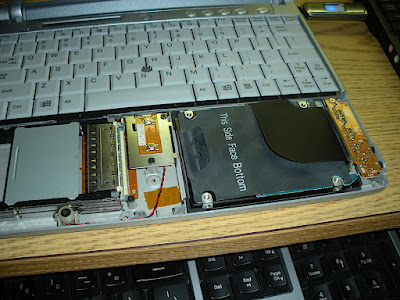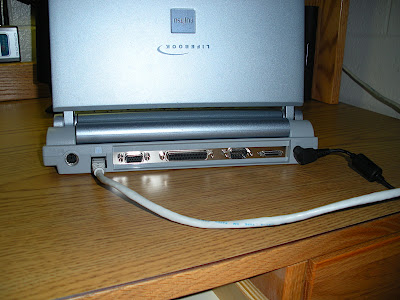I recently received a Fujitsu Lifebook B-2545. The B-Series doesn't seem to be the most documented sub-notebook in the world. Some models are more documented than others, such as the B-2131 and B-2569.
Some Specs:
- 10.5" touchscreen display
- 600MHZ mobile Intel P3
- 256MB RAM
- 30GB IDE HDD
- Realtek 8185 based Belkin WIFI card
- Fijitsu Port Replicator
- 6-cell extended battery
- Trackpoint w/ 2 buttons
The machine came to me running Windows 2000 Professional edition. Everything worked well with one exception. It was terribly slow and unstable, mainly due to Windows. There was one obvious solution: Install Ubuntu Linux. The machine has no floppy or CD drive, and the BIOS does not support USB booting, so installation of a new OS would be tricky.
The Installation Procedure
I removed the hard drive from the Lifebook and installed it in an external USB enclosure. I used my Asus eeePC, running Ubuntu, to partition and format the drive as follows: 1GB FAT32, 1GB linux swap, and 27GB EXT4. I then downloaded the mini Ubuntu installation ISO, totaling 12mb, and used
Unetbootin to create a bootable partition out of the 1GB FAT32 partition. I installed the hard drive back into the Lifebook. The BIOS booted off the first partition of the hard drive just as it would if the ISO was burn to a CD or flash drive.
It booted into a text based minimal installation menu which prompted for keyboard layout, language, etc, etc. It then configured my wired network adapter and proceeded to download the necessary files from the internet. It installed the newest kernel and the base hardware configuration and drivers required to run . After the installation completed, the machine booted to a command prompt where I updated all the packages and used aptitude to install a GUI based login manager and a very basic Gnome desktop environment.
Hardware
Everything worked upon initial startup excluding the touchscreen. Even my Belkin PCMCIA WIFI card was active and searched for networks.
WIFI
The card was unable to connect to any access point, encrypted or non-encrypted. The signal strength was very low on all networks, even those that were a foot from the machine. I come to find out that it was using the built in kernel driver rtl8180 and that there were some known issues with this driver and the 8185 chipset. I used the ndiswrapper tool to install the windows .inf driver file for the card. In order for this to work, I needed to blacklist the rtl8180 driver from the modprobe configuration file. The blacklist.conf file is located in the
/etc/modprobe.d/ folder. I just added an entry to the file that read: "blacklist rtl8180" without the quotations. Once I installed the windows driver, I had to associate the PCI ID of the card with the driver. This was acheived by the command: "sudo ndiswrapper -a
devid driver-name, replacing
devid with the device ID found by
sudo lspci and then sudo
lspci -n. To get the card to work, I had to type
sudo modprobe ndiswrapper and enter my administrator password. The card came to life and I was able to connect to my network!
Touchscreen
The touchscreen digitizer is connected via a multiplexed PS2 adapter with the trackpoint. After some heavy research, I found that there are some Panasonic ToughBooks that use this same screen digitizer setup. I ran across a
forum post that explained how to configure the touchscreen on the Panasonic ToughBook using the Hardware Abstraction Layer and a driver available from the repositories through aptitude. All that I need to do was copy and paste some code into a text file located in the proper location, stated in the forum post, and install the driver software using aptitude. Not only did that install the driver, it also installed a calibration utility that worked like a charm.
Software
I had to install the Gnome power manager, X-marks and Adblock for Firefox, and my favorite web app,
Dropbox! If you haven't heard about Dropbox before, have no fear. It is your ultimate sync and save application for all your computers. It gives you 2GB FREE cloud storage space and syncs files from any Mac, Windows, or Linux based PC seamlessly without having to do anything but store the file within the conveniently placed Dropbox folder. Referrals increase both your online storage space as well as the referee's space! If you are interested, give it a go, here is my referral
link. Gnome comes with Firefox, Open Office, Terminal, a text editor, a disk utility, and some other basic administration programs. The stripped down version I installed didn't include anything but the most basic theme, which was what I was looking for. This keeps the memory usage down while being less taxing on the CPU. All in all this is a pretty speedy little machine seeing that it only has 256mb RAM! Linux makes it far more usable. The final product is below.
I hope you enjoyed this post! Feel free to leave a comment. Thanks for reading!!
































